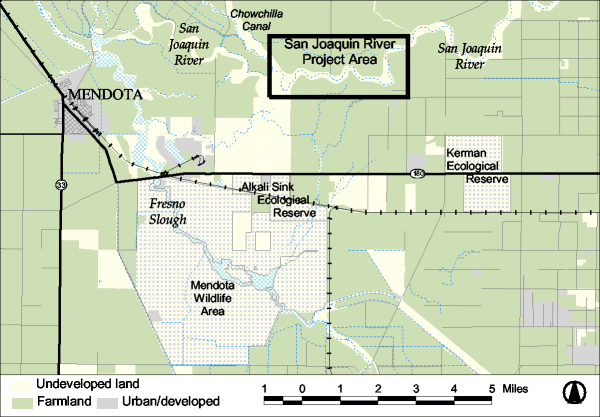Endangered Species Recovery Program | |
|
Home | News | Publications | Species profiles | Data and maps | About | Staff | Links | Department of Biological Sciences | CSU Stanislaus |
San Joaquin River Riparian Habitat Restoration Project (SJRRHRP)
The Bureau of Reclamation is proposing to dredge and recontour a 5-mile (8 km) stretch of the San Joaquin River channel between Mendota and Kerman in Fresno and Madera counties for enhanced flood monitoring and control. A Biological Assessment of the affected area is required for consultations under Section 7 of the U.S. Endangered Species Act of 1973. Accordingly, USBR requires current information on the potential presence of threatened and endangered species and other species of concern. The USBR requested that the California State University, Stanislaus, Endangered Species Recovery Program (ESRP) conduct occurrence surveys and habitat assessments for targeted species, and support interagency discussions regarding those species.
The project area begins at the San Joaquin River channel at Napa Avenue, approximately 9 miles (15 km) east of Mendota and 8 miles (13 km) west of Kerman, and continues downstream for about 5 river miles (8 km) to the diversion dam for the Chowchilla Canal. Our study area comprised the river channel from Napa Avenue to the diversion dam and extended to 10 feet (3 m) outside the levee on each side of the river channel.
Agriculture is the dominant land use in the area. The site is bordered by orchards, vineyards, and alfalfa fields, typically irrigated with flood irrigation, and non-irrigated grazing land. The vegetation along the roadsides and the river channel is dominated by mugwort, black mustard, and bractscale. There are a few scattered areas, each less than one acre (0.4 ha) in area, that can be characterized as Great Valley Mixed Riparian Forest and Great Valley Cottonwood Riparian Forest, which consist of willow species and Fremont's cottonwood, with mugwort as the dominant species in the understory. Most of the vegetation on the riverbanks and sandbars is non-native grass and ruderal species including ripgut grass, black mustard, telegraph weed and poison hemlock. On several sandbars in the river bottom approximately 2 miles (3 km) upstream of the diversion dam are stands of bush lupines. Blue elderberries are scattered through the site.
Biologists from ESRP conducted habitat assessments and field surveys for several endangered and threatened species along the 5-mile (8 km) dewatered stretch of the San Joaquin River between Mendota and Kerman in Fresno and Madera counties, California, during July-September, 2001. We concluded, based upon the absence of appropriate habitat, that the riparian brush rabbit, riparian woodrat, yellow-billed cuckoo, and giant garter snake were unlikely to be present. No blunt-nosed leopard lizards were seen while conducting transects on foot on the site, nor were bank swallows or evidence of their presence.
The valley elderberry longhorn beetle is likely to be present, based on the presence of numerous individuals of their host plant, the elderberry, some with possible evidence of the presence of the beetle, e.g., holes in the stems of appropriate size for exiting larvae (~1 cm dia.).
We caught no Fresno kangaroo rats in 1,200 trap nights of effort. One fox was briefly seen during a spotlight survey, but its identification by observers as a San Joaquin kit fox is not supported by the molecular analysis of a scat collected near the sighting by a trained dog and thus remains uncertain. Swainson's hawks were frequently seen on the site and may have nested there in the spring of 2001.
Thus, the most significant endangered species concern arising from this brief assessment involves the valley elderberry longhorn beetle, the host plant for which occurs throughout the site. Planning for the project will need to involve consultations with the USFWS to avoid elderberries, restore damaged areas, and transplant elderberries that cannot be avoided.
Assuming Swainson's hawks are nesting in the area, they are likely be unaffected by the project if their nest tree is avoided during any of the project operations, and if such operations occur outside the April-August nesting period.
